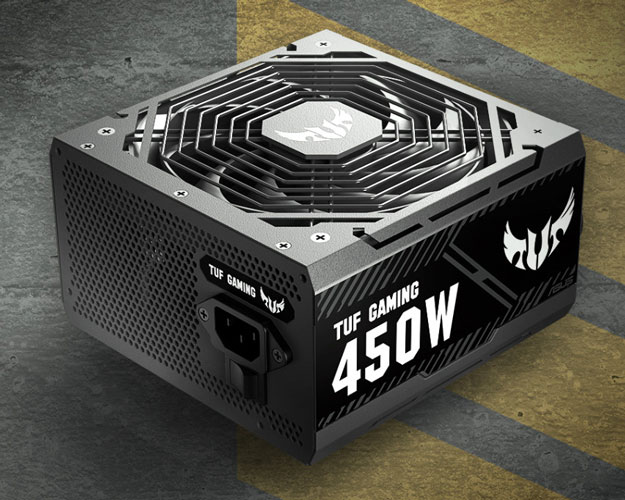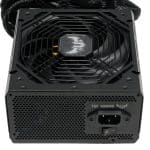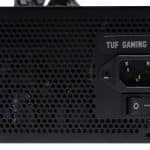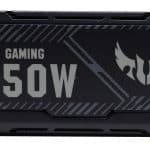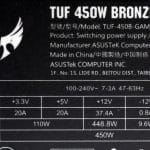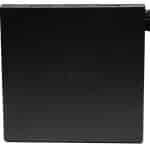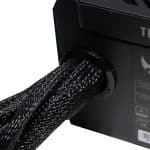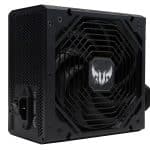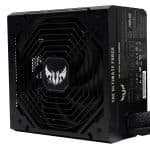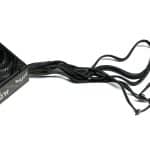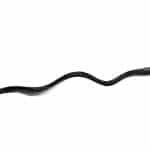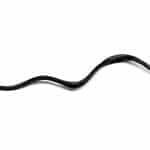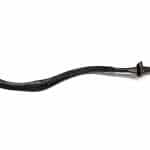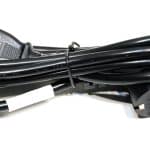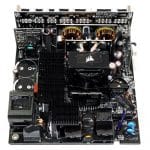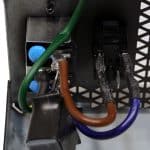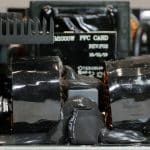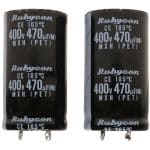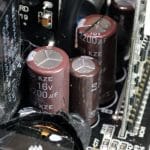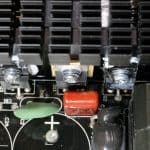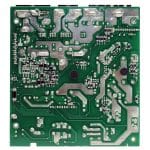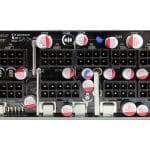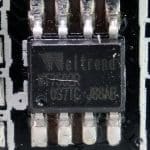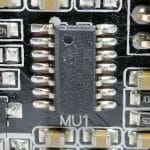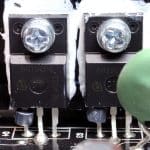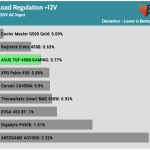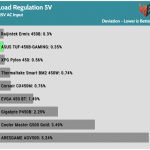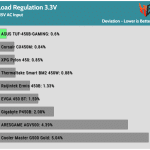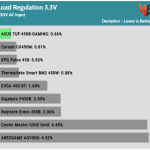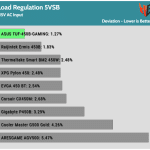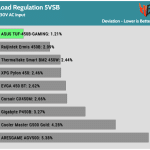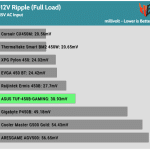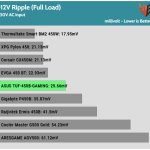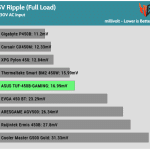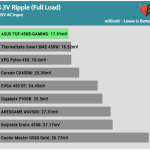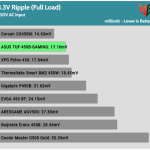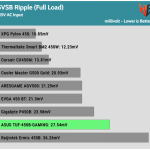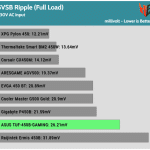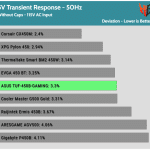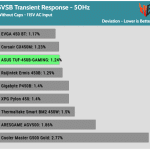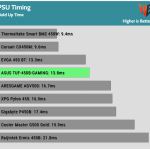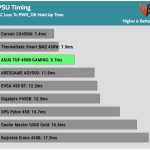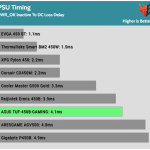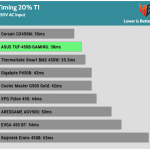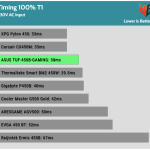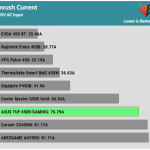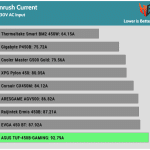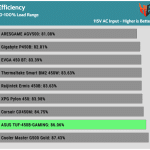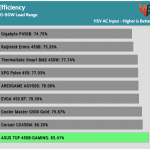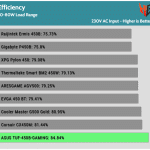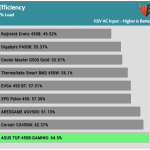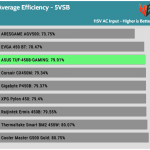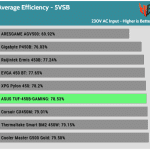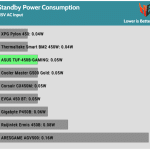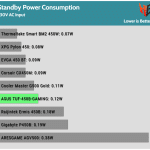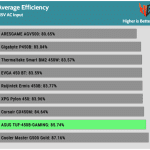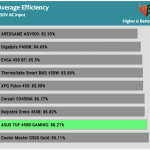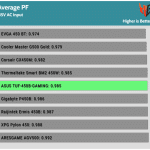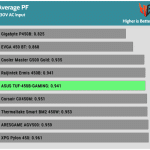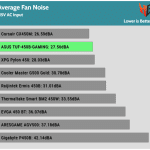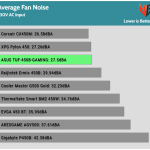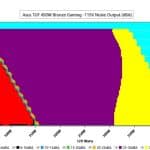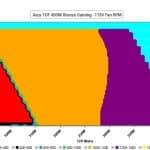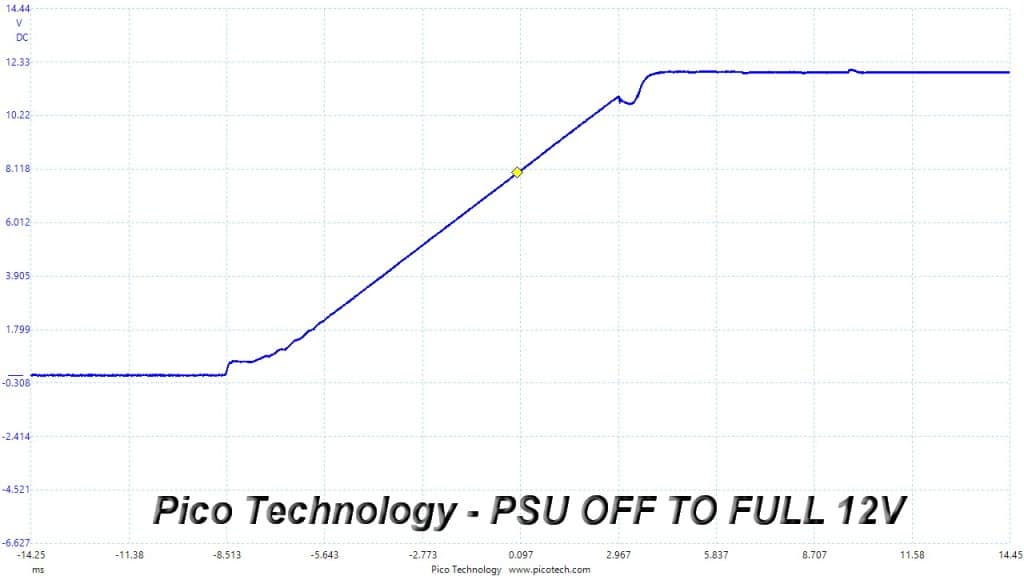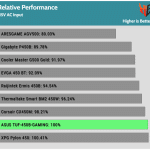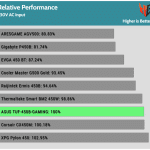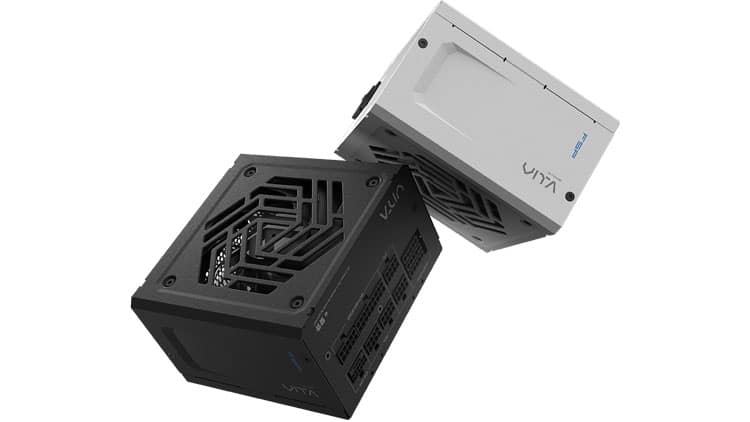The Asus TUF Gaming 450W PSU is ideal for systems with low energy needs, because it offers high performance and it is supported by a six-year warranty. It is more expensive than the average in its category, but the platform that it uses is advanced.
After the TUF 550 review, I thought to look at the 450W model, which is ideal for small systems, either office PCs or download or media streaming stations. The TUF Gaming 450 uses the same platform as the Corsair CX450 derived from Great Wall. Corsair had two OEMs for the CX line, CWT and GW. Both had about the same performance, and you couldn’t know which you would get, but it didn’t matter much. Since Corsair decided to terminate the CX line because of the increased production cost of its platform, Asus saw an opportunity and took it. I am glad someone took over this platform and kept it on the market. It is like an exciting but expensive TV show is canceled from one platform, and another takes it over.
The TUF 450 has a Silver efficiency rating from Cybenetics. In noise, it scores A- which is decent for its category.
- Manufacturer (OEM): Great Wall
- Max Power: 450W
- Cybenetics Efficiency: [115V] Silver (85-87%)
- 80 Plus Efficiency: Bronze
- Noise: Cybenetics A- (25 – 30 dBA)
- Compliance: ATX12V v2.53, EPS 2.92
- Alternative Low Power Mode support: Yes
- Power 12V: 448.8W
- Power 5V + 3.3v: 110W
- Power 5VSB: 15W
- Cooling: 135mm Double Ball-Bearing Fan (CF1325H12D)
- Semi-Passive Operation: No
- Modular Design: No
- High Power Connectors: 1x EPS (single cable), 2x PCIe 6+2 pin (single cables)
- Peripheral Connectors: 5x SATA (2x cables), 4x 4-pin Molex (single cable)
- ATX/EPS Cable Length: 600/820mm
- Distance between SATA connectors: 110mm
- Distance between 4-pin Molex connectors: 150mm
- In-cable capacitors: No
- Dimensions (W x H x D): 150 mm x 85 mm x 150 mm
- Weight: 1.91 kg (4.21 lb)
- Warranty: 6 years
Box & Bundle
The product didn’t come in a box, so you won’t find any relevant photos here.
Product Photos
The exterior design is appealing, especially if you consider the budget-oriented category that it belongs. Ok, it might not be as affordable as some low-end units, but you get what you paid.
Cables
| Captive Cables | |||||
| Description | Cable Count | Connector Count (Total) | Gauge | In Cable Capacitors | |
|---|---|---|---|---|---|
| ATX connector 20+4 pin (600mm) | 1 | 1 | 18-20AWG | No | |
| 4+4 pin EPS12V (820mm) | 1 | 1 | 18AWG | No | |
| 6+2 pin PCIe (620mm+100mm) | 1 | 2 | 18AWG | No | |
| SATA (420mm+110mm+110mm) | 1 | 3 | 18AWG | No | |
| SATA (410mm+110mm) | 1 | 2 | 18AWG | No | |
| 4-pin Molex (400mm+150mm+150mm+150mm) | 1 | 4 | 18AWG | No | |
| Modular Cables | |||||
| AC Power Cord (1390mm) – C13 coupler | 1 | 1 | 18AWG | – | |
There are enough cables and connectors to cover the unit’s capacity fully. On top of that, the ATX and EPS cables are long, especially the latter. It is rare to find a PSU with such a long EPS cable, ensuring that there won’t be any compatibility issues even with enormous cases.
Protection Features
| OCP (Cold @ 21°C) | 12V: 50.6A (135.29%), 11.919V 5V: 35A (175%), 5.125V 3.3V: 35A (175%), 3.324V 5VSB: 4.8A (160%), 5.024V |
| OCP (Hot @ 39°C) | 12V: 50.4A (134.76%), 11.929V 5V: 35A (175%), 5.129V 3.3V: 35A (175%), 3.330V 5VSB: 4.7A (156.67%), 5.017V |
| OPP (Cold @ 26°C) | 591.51W (131.45%) |
| OPP (Hot @ 38°C) | 591.63W (131.47%) |
| OTP | ✓ (115°C @ 12V Heat Sink) |
| SCP | 12V to Earth: ✓ 5V to Earth: ✓ 3.3V to Earth: ✓ 5VSB to Earth: ✓ -12V to Earth: ✓ |
| PWR_OK | Accurate but lower than 16ms |
| NLO | ✓ |
| SIP | Surge: MOV Inrush: NTC Thermistor |
OCP at 12V and OPP are correctly set. This is not the case for the minor rails, where OCP triggering points are silly high. GW didn’t pay any attention there. I cannot explain it otherwise.
Part Analysis
| General Data | – |
| Manufacturer (OEM) | Great Wall |
| PCB Type | Single Sided |
| Primary Side | – |
| Transient Filter | 4x Y caps, 2x X caps, 2x CM chokes, 1x MOV |
| Inrush Protection | NTC Thermistor SCK-1R58 (1.5 Ohm) |
| Bridge Rectifier(s) | 1x GBU1508 (800V, 15A @ 100°C) |
| APFC MOSFETs | 1x Advanced Power AP30SL60WL (650V, 16.5A @ 100°C, Rds(on): 0.13Ohm) |
| APFC Boost Diode | 1x STMicroelectronics STTH8S06FP (600V, 8A) |
| Bulk Cap(s) | 1x Lelon (450V, 270uF, 2,000h @ 105°C, LSG) |
| Main Switchers | 2x STMicroelectronics STF13NM60N (600V, 6.9A @ 100°C, Rds(on): 0.36Ohm) |
| APFC Controller | Champion CM6500UNX & CM03AX |
| Resonant Controller | Champion CM6901X |
| Topology | Primary side: APFC, Half-Bridge & LLC converter Secondary side: Synchronous Rectification & DC-DC converters |
| Secondary Side | – |
| +12V MOSFETs | 2x STMicroelectronics STP100N6F7 (60V, 75A @ 100°C, Rds(on): 5.6mOhm) |
| 5V & 3.3V | 2x DC-DC Converters |
| Filtering Capacitors | Electrolytic: 3x Elite (3-5,000h @ 105°C, EJ), 3x Teapo (1-3,000h @ 105°C, SC), 1x Teapo (1-2,000h @ 105°C, SZ), 1x Teapo (105°C, TB), 1x Teapo (105°C, TA) Polymer: 4x Lelon, 2x no info |
| Supervisor IC | IN1S429I – DCG |
| Fan Model | Champion CF1325H12D (135mm, 12V, 0.6A, Double Ball Bearing) |
| 5VSB Circuit | – |
| Rectifier | 1x SBR |
| Standby PWM Controller | Power Intergrations TNY278PN |
Great Wall is the OEM of all Asus TUF-Gaming units, and the platform is modern, too modern for this category, I could say. All other brands, except Cooler Master, choose older designs to achieve the same performance, which is why Corsair ended its CX line, which used the same platform. Half-bridge and LLC resonant converters are typically found in higher efficiency and more expensive PSUs, so if you want to offer something affordable, it will be tough to do so using such a modern platform. This is why we find a low-end cap on the APFC converter. I am not a big fan of Lelon caps because this brand doesn’t have a clear rap sheet. I’ve read many horror stories about Lelon caps, and I hope this brand has improved its quality over the years. On the contrary, Elite and Teapo caps are reliable and the best alternative to expensive Japanese-branded caps.
The high-quality cooling fan uses double ball bearings, which won’t have a problem under high operating temperatures. The only unit following closely the fan choice that Asus made is the XPG Pylon 450, which uses an FDB fan by Hong Hua. Still, DBB fans are superior to similar spec FDB ones. It is just that you need to be careful with the fan speed profile because DBB fans are noisier.
Load Regulation
Load regulation is tight on all rails.
Ripple Suppression
Ripple suppression is good.
Transient Response
It is weird to see double-forward topology platforms achieving better results at 12V. For this category’s standards, the TUF 450 performs well at 12V. The worst rail is the 3.3V one.
Hold Up Time
The hold-up time is short. The power-ok signal is accurate, at least.
Timings
The PSU supports Alternative Low Power Modes.
Inrush Current
Inrush currents are sky-high with both voltage inputs I tried.
Efficiency Normal, Light & Super-Light Loads
Efficiency is high enough on all load ranges. With normal loads, only the Cooler Master G500 takes the lead but loses with light loads.
Average Efficiency 5VSB
The 5VSB rail has decent efficiency.
Vampire Power
I want to see below 0.1W vampire power with 230V input.
Average Efficiency
The efficiency difference with the Gold G500 unit is significant with 115V, but the gap gets smaller with 230V.
Average PF
The APFC converter needs tuning for higher PF readings with 230V input.
Average Noise
The average noise output is low enough. The efficient platform helps in that, along with the large fan.
Fan Noise & Speed Maps @ 28-32 °C
The semi-passive operation lasts up to 150W, with a minimal load on the minor rails. Overall, it doesn’t last long. With higher than 150W, the PSU’s fan is in the 25-30 dBA zone, while with more than 310W, it enters the 30-35 dBA region.
Turn-On Transient Tests
In the 550W unit, the voltage drop at 12V was huge in this test. In the 450W model, the problem is not as severe, but the voltage step before the rail’s settle down to the nominal voltage can create compatibility issues with some mainboards.
Overall Performance
With 115V input, the TUF 450 scores second, and at 230V, it achieves third place. Since I use the new performance algorithm, the TUF 450 loses points for the ultra-high OCP triggering points on the minor rails. Moreover, the competition might use less advanced platforms, which are well-tuned, though, for better performance.
Epilogue
The Asus TUF Gaming 450 is a fine, low-capacity PSU with good build quality if I exclude the Lelon caps. In any case, Asus supports it with a six-year warranty, so Great Wall, its manufacturer, must be confident about the reliability of the few Lelon caps that it uses. Truth be told, the APFC cap doesn’t get hot since airflow towards it is unrestricted. What matters the most is the quality of the filtering caps on the secondary side, and there you will find Elite and Teapo electrolytic caps, which are reliable. On the secondary side, the only Lelon caps are some polymer ones, which are tolerant to heat since they don’t use electrolytes.
The XPG Pylon 450 and the Corsair CX450M meet the TUF’s performance, offering quiet operation, so choosing between these three units is challenging. I would suggest buying the one you find at the best price. The Asus unit uses a more advanced platform but cannot surpass the performance of the PSUs above. Nonetheless, it beats them in efficiency. Notably, I could say.
- Full power at 42°C
- High overall performance
- Efficient
- Good ripple suppression
- Tight load regulation
- Quiet operation
- Good build quality (except the Lelon bulk cap)
- ALPM support
- Low vampire power at 115V
- DBB fan
- 820mm long EPS cable (!)
- 150mm distance between the peripheral connectors
- 6-year warranty
- Short hold-up time
- High inrush currents
- Mediocre transient response at 3.3V
- Silly high OCP triggering points on the minor rails
- Not a big fan of Lelon caps
- Low PF with 230V
- I noticed a voltage step at 12V during the turn-on transient tests
